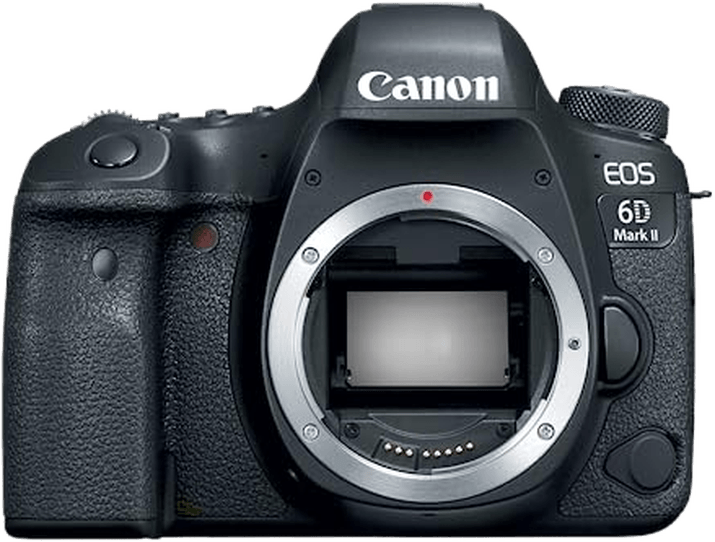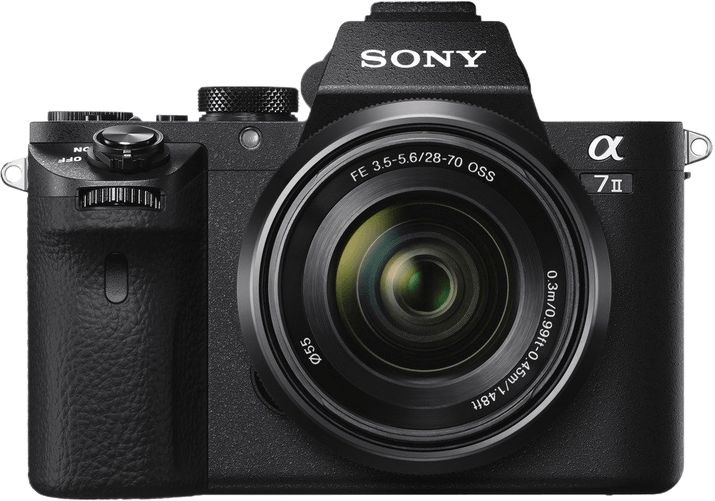Canon EOS 6D Mark II vs Sony a7 II Comparison
Canon EOS 6D Mark II

Sony a7 II

The Canon EOS 6D Mark II takes the lead with a score of 71/100, while the Sony a7 II lags behind at 68/100. Both cameras share some common specs, such as being released in the 2010s and having a similar launch price range ($2000 for Canon and $1600 for Sony).
The Canon EOS 6D Mark II, a DSLR camera, excels with its lighter weight of 453g and larger size of 144 x 111 x 75mm, making it more comfortable for extended use. On the other hand, the Sony a7 II, a mirrorless camera, boasts a compact design with dimensions of 127 x 96 x 60mm but is heavier at 599g.
Taking everything into account, the Canon EOS 6D Mark II emerges as the better option due to its higher score, lighter weight, and comfortable size. However, the Sony a7 II may still appeal to those seeking a more compact camera.
Canon EOS 6D Mark II vs Sony a7 II Overview and Optics
The Sony a7 II outperforms the Canon EOS 6D Mark II in optics, with a score of 78/100 compared to Canon’s 69/100. Both cameras share several similarities in specifications, including a full-frame CMOS sensor, which allows for excellent image quality and low-light performance. They also have proprietary processors – the Canon 6D Mark II uses the Digic 7, while the Sony a7 II is equipped with the Bionz X processor.
The Sony a7 II has a higher DXOMARK sensor score of 90, compared to the Canon 6D Mark II’s score of 85. This difference reveals that the Sony a7 II provides better image quality and dynamic range. Additionally, the Sony a7 II features built-in image stabilization, which helps to reduce camera shake and improve image sharpness. This advantage is particularly useful for photographers who shoot handheld or in low-light conditions.
On the other hand, the Canon 6D Mark II has a slightly higher megapixel count of 26.2, compared to the Sony a7 II’s 24.2 megapixels. This allows for slightly larger prints and more cropping flexibility. Furthermore, the Canon 6D Mark II has a faster shooting speed of 6.5 frames per second, making it more suitable for capturing fast-moving subjects or action photography.
The lens mounts also differ, with the Canon 6D Mark II using the Canon EF mount and the Sony a7 II employing the Sony E mount. This distinction impacts the lens options available to photographers, with each system offering a unique range of lenses to suit various shooting needs.
Considering the optics performance, the Sony a7 II provides better image quality, dynamic range, and stabilization features. However, the Canon 6D Mark II offers a higher megapixel count and faster shooting speed. Ultimately, the choice between these two cameras will depend on individual preferences and the specific requirements of the photographer.
Canon EOS 6D Mark II vs Sony a7 II Video Performance
The Canon EOS 6D Mark II edges out the Sony a7 II in video capabilities with a score of 57/100 compared to the Sony’s 56/100. Both cameras have Full HD video resolution and max video dimensions of 1920 x 1080. However, there are some differences that make the Canon 6D Mark II the better option for video.
The Canon 6D Mark II offers a max video frame rate of 30fps, which is lower than the Sony a7 II’s 60fps. Despite this, the Canon has a built-in time-lapse functionality, making it more versatile for capturing creative video content. This feature is absent in the Sony a7 II, limiting its video flexibility.
On the other hand, the Sony a7 II’s higher max video frame rate allows for smoother, more professional-looking footage. This is particularly useful for fast-paced action or sports videos. However, the lack of time-lapse functionality hinders its overall video capabilities, and it falls short of the Canon 6D Mark II in this aspect.
In comparing the video capabilities of the Canon EOS 6D Mark II and Sony a7 II, the Canon’s built-in time-lapse functionality gives it an edge over the Sony, despite having a lower max video frame rate. The Sony a7 II’s higher frame rate is an advantage for certain video applications, but its lack of time-lapse functionality makes it less versatile overall.
Canon EOS 6D Mark II vs Sony a7 II Features and Benefits
The Canon EOS 6D Mark II emerges as the winner in the features category with a score of 83/100, compared to the Sony a7 II’s score of 57/100. Both cameras share some common specifications, such as a 3-inch screen size, flip screen, and Wi-Fi connectivity.
The Canon 6D Mark II outperforms the Sony a7 II in several areas, including a touchscreen, GPS, and Bluetooth capabilities. The touchscreen allows for easier navigation and control, while the GPS feature is useful for geotagging photos. Bluetooth allows for seamless connection to other devices, making file transfers and remote control more convenient.
On the other hand, the Sony a7 II boasts a higher screen resolution of 1,230,000 dots, compared to the Canon 6D Mark II’s 1,040,000 dots. This results in a sharper and more detailed display on the Sony a7 II. However, the lack of a touchscreen, GPS, and Bluetooth on the Sony a7 II is a significant drawback when compared to the Canon 6D Mark II.
To conclude, the Canon EOS 6D Mark II is the better camera in terms of features, due to its touchscreen, GPS, and Bluetooth capabilities. The Sony a7 II’s higher screen resolution is an advantage, but it is not enough to outweigh the additional features offered by the Canon 6D Mark II.
Canon EOS 6D Mark II vs Sony a7 II Storage and Battery
The Canon EOS 6D Mark II triumphs over the Sony a7 II in storage and battery with a score of 45/100 compared to 21/100. Both cameras share similarities, including a single memory card slot and compatibility with SD, SDHC, and SDXC cards. However, the Canon 6D Mark II has a substantial advantage with its battery life, providing 1200 shots per charge, while the Sony a7 II delivers only 350 shots. The Canon 6D Mark II uses an LP-E6N battery type, whereas the Sony a7 II utilizes an NP-FW50 battery type.
The Sony a7 II does have an additional benefit, accepting Memory Stick Duo, Pro Duo, and Pro-HG Duo cards. Unfortunately, this advantage is not enough to surpass the Canon 6D Mark II’s superior battery life. Neither camera offers USB charging capabilities.
The Canon EOS 6D Mark II clearly outperforms the Sony a7 II in storage and battery, making it the better choice for extended shooting sessions and overall convenience.
Canon EOS 6D Mark II vs Sony a7 II – Our Verdict
Are you still undecided about which camera is right for you? Have a look at these popular comparisons that feature the Canon EOS 6D Mark II or the Sony a7 II:

